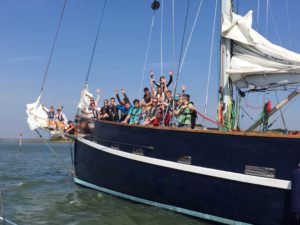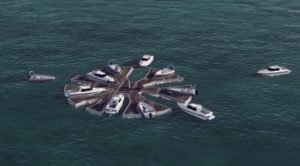Catching up with Ellen – the world’s largest electric ferry
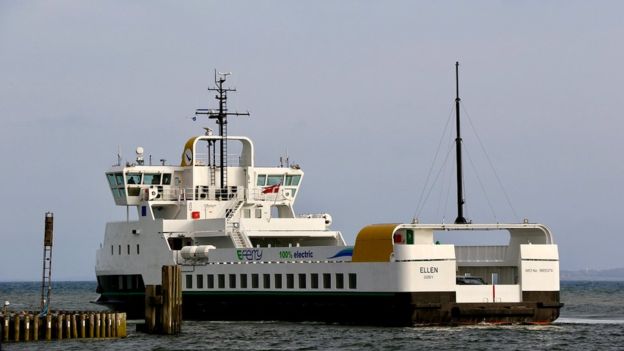
In August 2019, Leclanché (battery system provider) announced the world’s largest electric ferry had completed its first commercial voyage.
Ellen connected the ports of Søby and Fynshav (Denmark).
Six months on, Halfdan Abrahamsen, an information officer from Ærø EnergyLab, tells the BBC: “Ferry shipping in general is very dirty business.” Ships usually use marine diesel or heavy fuel oil, “which is just about the bottom of the food chain when it comes to product from refineries”. But he says, the only oil onboard Ellen is for the gearbox and in the kitchen for making French fries.
Powered entirely by batteries, Ellen is something of a Tesla among ferries. Fully charged, the 60m vessel can sail 22 nautical miles with up to 200 passengers and 30 cars onboard. That’s a roughly 40km (25-mile) round-trip, and seven times further than other electric ferries.
The 840 lithium-ion batteries supplied by Swiss firm Leclanché, are stacked from floor to ceiling in two battery rooms.
Totalling 4.3MWh, this is the largest battery capacity at sea and equivalent to the average amount of electricity a UK household consumes each year.
After a 70-minute voyage, Ellen arrives at the harbour in Søby and moors alongside the charging station. A mechanical arm plugs in and recharges the batteries in less than 25 minutes with clean energy supplied by local wind turbines.
Ellen is not fully operational just yet, and it hasn’t all been smooth sailing. Building a boat with so many batteries is complex and since being launched some battery cells have been replaced, says the BBC.
Battery weight
“They’re [batteries] getting lighter and more energy dense, but they’re still heavy,” Trine Heinemann, the E-Ferry project coordinator explains.
“The more energy you need, the more batteries you need, the more weight you add. You then have to start thinking about how do we take other weight away from the ship? How do you build the most energy-efficient ship?”
A lower resistance design and more lightweight materials were used, contributing to Ellen’s low running costs.
“We are paying maybe 25% of what you would pay for running a similar diesel vessel,” says Trine, “so that’s the significant saving.”
The emission-free ferry is expected to reduce CO2 emissions by 2,000 tonnes a year. It’s part of an EU-backed project to develop green ferries for longer routes.
The ferry has cost €21.3m (US$23.6m; £18.3m), with the EU’s Horizon 2020 programme funding €15m.
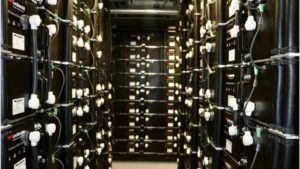
Battery room (credit: Adrienne Murray)
“It’s maybe 40% more expensive than a conventional diesel vessel,” Trine tells the BBC.
“Then you still have the transformer and the electrical infrastructure. So, in terms of establishing an electrical vessel, we are looking at a significantly higher cost.”
So, while battery power is certainly greener, is it commercially viable? The team believes so.
“Some say within 14 months you break even and then it’s saving from then on. We’re being a little bit more conservative and saying maybe four or five years,” she says.
Cost effective batteries
Batteries are getting more cost-competitive says Dr Tristan Smith, a shipping and energy expert from University College London, thanks largely to better technology and stricter emissions rules.
“If you have strong air quality regulation then you aren’t able to burn the worst quality marine fuels,” he says, “which then makes the battery more competitive, because it’s now competing against the more expensive fossil fuel.”
The shipping industry is responsible for around 3% of global CO2 and greenhouse gas emissions. In April 2018, the International Maritime Organisation set new targets to reduce these emissions by “at least 50% by 2050 compared to 2008” levels.
That’s spurring industry players to explore new emission-cutting measures including alternatives fuels like LNG, biofuel, also hydrogen and ammonia which Dr Smith thinks show most promise.
Retro fitting
Since the first fully electric ferry was launched in Norway four years ago using Siemens technology, Nordic countries have led a shift towards hybrid and electric power.
Operator Norled now plans to build the world’s first hydrogen-electric ferry.
“The technology is ready,” says Danfoss Editron’s, Kimmo Rauma. “The question is that the maritime industry is not the fastest to change.”
His firm has supplied electric technology for patrol-boats, icebreakers, and fish farming service boats.
It also developed Asia’s first e-ferry in Taiwan. He says retrofitting older diesel vessels with electric engines, particularly in city harbour areas, is a “big opportunity” to reduce pollution.
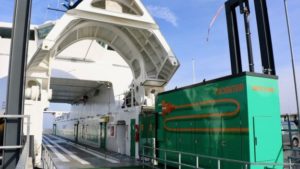
Recharging at port (credit: Adrienne Murray)
However, experts say that scaling up battery power for large ships has significant limitations.
“The common denominator for successful battery use is that the vessels operate close to shore,” says Maria Skipper Schwenn, a director at industry body, Danish Shipping.
“The operational reach is limited simply due to the capacity of the battery itself. It’s simply not possible today when you are sailing more than 10 or 20 days at sea. In addition to that you need an enormous charging capacity in the port.”
“With the technology we have right now… it doesn’t seem like a viable solution for the deep-sea shipping. But for ferries, supply ships and tugboats, it’s an excellent solution.”
Read the full article online.
E-ferry is part of the Danish Natura project, which aims to provide environmentally friendly transport for local residents. This project was initiated in 2015 and was funded by the European Union through the Horizon 2020 and Innovation Program.


